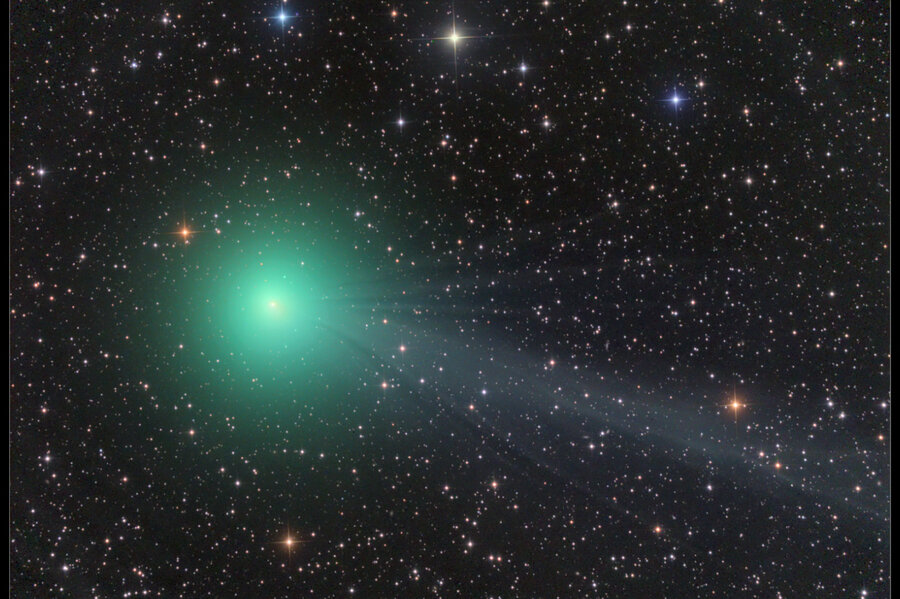New Year's surprise: a comet you can see with the naked eye
Grab the binoculars, or if you live in a location free of urban glow, just use your eyes to enjoy a year-end surprise: Comet C/2014 Q2 – Comet Lovejoy or Comet Q2 for short.
Comet Lovejoy is making its first pass by the sun in 11,500 years, and because the planets have tweaked its orbit during its approach, it won't be back for another 8,000 years.
The comet, discovered Aug. 17, initially wasn't expected to become a naked-eye object. But it has brightened, highlighting comets' tendencies to turn brightness predictions on their heads. Often, it's been the "comet of the century" that has turned out to be a visual dud. Think Comet Kahoutek in 1973, for instance.
When it comes to predicting a comet's brightness, "there are no nice, clean set of rules you can apply," says Alan Delamere, who has designed instruments for robotic space missions, including the European Space Agency's Giotto mission, which made the first close-up observations of Comet Halley in March 1986, and has served on the science teams of several NASA missions, including the Mars Reconnaissance Orbiter.
This time around, skywatchers are getting an unexpected treat.
Comet Lovejoy was discovered by Terry Lovejoy, an amateur astronomer who lives outside of Brisbane, Australia, and has four other comet discoveries to his credit since 2007.
The comet currently appears as a fuzzy blob in the constellation Lepus, almost on a direct line below Orion's brightest star Rigel and nearly level with Sirius, the brightest star in the constellation Canis Major, Orion's hunting hound.
Weather, as well as a moon trending toward full through Jan. 4, may make the viewing a bit challenging. But conditions should get better. On Jan. 7, Comet Lovejoy makes its closest approach to Earth at some 44 million miles away, before making its closest approach to the sun on Jan. 30.
The comet also is rising higher in the northern sky. By Jan. 7, the comet will be appearing to the right of the bottom half of Orion's bow, just above the constellation Eridanus. With the comet's path taking it ever higher in the sky each night and the moon heading to its "new" phase, the comet should put on a good show in mid January, and remain a binocular object through at least through the end of the month, depending on your location and levels of urban glow.
Because of its long travel time through the solar system, Comet Lovejoy falls into the long-period category of comets. These comets come from an extended cloud of orbiting, oddly shaped relics composed of ice and dust from the dawn of the solar system. It's known as the Oort cloud. The cloud begins roughly 2,000 to 5,000 astronomical units from the sun, or 2,000 to 4,000 times the distance from Earth to the sun. By some estimates, the outer edge of the Oort cloud, with billions of comet-like objects, extends to 1.5 light-years from the sun – slightly less than halfway to the sun's nearest neighbor, Proxima Centauri.
Comets whose orbits bring them within the inner solar system naturally brighten as they warm and the ices they contain heat up and jump from ice to gas with no intermediate stage as a liquid. This process, known as sublimation, generates the gas that glows in the comet's halo, or coma, as well as the tails of dust and ionized gas that trail away from it.
But how bright that coma glows varies comet by comet, depending the amount of ices it contains, how warm it gets, the number of passes it has made into the inner solar system, and from a skywatcher's point of view, how close it comes to Earth, notes Carey Lisse, a senior research scientist at Johns Hopkins University's Applied Physics Laboratory in Laurel, Md.
Long-period comets, such as Comet Lovejoy, spend most of their time traveling through the farthest reaches of the sun's gravitational influence, where temperatures hover around -360 degrees Fahrenheit. If they never reach the inner solar system as they orbit, they don't thaw enough to release much gas. If they do, and ices are close enough to the surface, they can undergo an initial burst of brightening.
The first gases to appear come from a comet's reservoir of frozen carbon monoxide, then carbon dioxide, and finally water ice, Dr. Delamere adds.
Brightening can continue, fizzle, or fluctuate, depending on the structure of the core and how much ice gets exposed to the sun's warmth as the comet heads toward its closest approach.
Indeed, the structure of comets are of keen interest beyond trying to estimate changes to a comet's brightness. Scientists haven't yet figured out how they form, acknowledges Dr. Lisse.
Models of early solar-system formation can show how dust grains a millionth of a meter across grow to the size of BBs, he says. And they can reconstruct the pathway that leads from comet-sized objects perhaps a half a mile across to planets thousands of miles across.
But what happens in between remains a mystery, presumably locked up within comets themselves. Comets' structure and composition reflect the environment in which they formed, which would have varied somewhat from one region of the protoplanetary disk to another.
Little wonder then that comets are like cats, Lisse says. "They're very interesting, and they do what they want."






